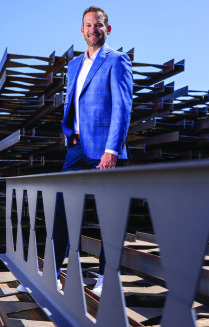
Mesa-based Next Level Steel, a structural steel fabricator, has completed its second steelyard in Goodyear, where the company is creating products such as innovative castellated beams, which are stronger than traditional I-beams. The original steelyard is in Mesa, 522 W. McKellips Road.
Founded in 2020 by second-generation steel fabricator and Phoenix resident Brandon Bell, NLS provides design, fabrication and steel-erection services for clients including general contractors such as Whiting Turner, Layton and AR Mays. Born and raised in Yuma, he attended Mesa Community College and then helped build the family’s ornamental fence company, started by his father.
Recent Valley projects completed using the company’s castellated steel beams include the Elliot Mesa Commerce Center and the Gateway Industrial Center, both in Mesa. In Yuma, the dining hall at the Marine Corps Air Station incorporates Next Level Steel’s products, and the $40 billion TSMC semiconductor factory in North Phoenix will, too.
Because the 28-acre Goodyear facility will more than triple capacity, Bell said NLS has added 40 skilled steelworkers and will add another 40 in 2024 to support its new fast-growing Castellated Structural Group division. “We have helped to bring back the concept, which first appeared in World War II. During the last year or so, we have brought them back to the area because of our high demand for warehouse and plant construction.”
The company has also hired a vice president of business development, Scottsdale’s Lauren Fisher, who will help expand operations across the western United States, starting with a six-building, 526,510-square-foot industrial complex in the first quarter of 2024 in Las Vegas; the developers partnered with the developer of the Elliot Mesa Commerce Center project and liked the castellated beams and is bringing it to the Nevada division.
A 60-foot span is the industry standard, but some projects need 70 feet, and the castellated beam can also handle that, matching the capacity of wood and traditional steel joist roofs. And, to save weight, castellated steel beam roofs are shallower by a foot than a similar span built with wood and steel joists. They also require less equipment to erect and allow for smaller supports and foundations.
In addition, they also replace traditional precast concrete parking structures, lessening the concrete needed for the structure and the footers and foundation required because of the concrete weight. “And, they bring more natural light into the structure and can support rooftop solar arrays without building additional roof structures or supports,” he said.
Here’s how the process works. After receiving steel I-beams from Arkansas, Oklahoma and other American-based steel plants, the company splits them apart with a plasma laser, then precisely welds them together. The “teeth” carved in the beams are offset, creating a series of precise hexagonal holes; these help make the steel beam stronger, faster to erect and delivered with less lead time than traditional roofing structures. The original beams are about 14 inches tall; they then increase to about 22 inches tall, making the beam taller and stronger without adding weight.
Next Steel makes all the castellated steel in Goodyear on a custom fabrication line using proprietary technology developed with the assistance of Scottsdale-based PK Associates. In addition, Bell says that “with the refinements in our manufacturing processes and the new facility’s higher volumes, we can compete with traditional roof joist companies even if their prices and lead times stabilize,” Bell said.
The city of Goodyear variously benefits. For one, the new steel plant repurposed a former Robb & Stuckey furniture-assembly site, providing the company with room to grow and the city with a revitalized source of revenue.
And Darah Mann, economic development deputy director city of Goodyear, said, “Advanced manufacturing and e-commerce facilities are integrating technological innovations, which increase productivity and reduce risk of injury while creating higher-paying jobs for our residents. Castellated beams help meet the challenges of keeping pace in our growing region.”
Bell said the company has thrived despite opening during the COVID-19 pandemic.
“During COVID there was a surge in warehouse building, but we previously didn’t focus on that business because traditionally most commercial warehouses/light industrial spaces in Arizona are built with wooden roofs and use little structural steel except for the steel joists,” he explained.
“But because of COVID, the price for roof-building joists tripled as manufacturers struggled with supply chain issues and could not keep up with demand.”
Next Steel began in 2020 with eight employees and now has 150-plus.

